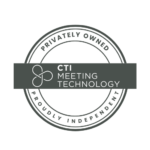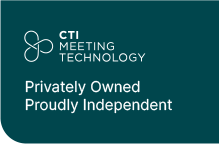Creating a recognizable brand is one of the most important parts of setting up a business. Likewise, developing a solid brand for your event offers a more enjoyable experience for participants they will remember for years.
But how do you develop a successful event brand? The process goes beyond creating a catchy slogan and logo, but meeting organizers must establish a strong image that leaves a lasting impression on attendees, speakers, and sponsors alike.
Establishing a Strong Event Brand
A clear and consistent event brand sets the tone for the event, enhances attendee engagement, and creates a sense of community. Whether planning a small symposium or a large-scale international conference, quality branding can make your event stand out and resonate with your audience long after it has ended.
So, let’s explore how to set up a successful meeting branding with the help of event software:
Event Branding Basics
In short, event branding is about creating a unique and consistent visual identity for your event. Simple, right? Think about well-known events, like TED Talks. The branding is so unique that anyone can recognize a TED Talk just by the colors and format used. Event organizers should strive to create a recognizable image for their meetings that is also easily tied to their organization. That means, just by looking at any of your event elements, such as the logo, anyone knows what’s the theme of your meeting.
Thus, creating your event brand should be a shared effort among multiple areas of your organization: marketing, planning, finance, sponsorships, etc. But event branding goes beyond just the visual elements—it’s about crafting a cohesive experience that aligns with the values and objectives of your event.
For scientific events, where the focus is often on knowledge sharing and professional networking, branding plays a critical role in communicating the purpose of your event and creating an atmosphere that fosters meaningful connections.
Having a strong brand can also support your marketing efforts. It makes your event more shareable and memorable to attendees. It makes the difference between a forgettable event and participants talking about it weeks (even months!) later.
Here are the must-have elements that you need to create a powerful brand for your scientific meetings:
- Event Name: The name of your event should clearly communicate its theme and be easy to memorize.
- Event Logo: Choose a simple but visually appealing and easily recognizable logo. It should reflect the event’s theme and your organization’s identity.
- Catchy Slogan: “Just do it”, “I’m Lovin’ It” or “Think Different” are instantly recognizable slogans. Just by reading them, you know which brand they belong to. Come up with a brief but memorable phrase related to your event and pair it with every aspect of your marketing efforts.
- Brand Colors: Create a brand palette to develop a consistent visual identity across all event materials.
- Consistent Voice: Be consistent with your communication tone across multiple channels, reflecting the event value and keeping in mind your target audience. A formal tone and communication through B2B channels might be fitting if you host a large and prestigious conference.
- Marketing Materials: These include flyers, brochures, posters, infographics, etc. Digital or printed, keep in mind to showcase your event’s brand identity.
- Social Media Presence: The channels you choose to promote your event might differ depending on the type of meeting you’re hosting and your audience, but it’s crucial to be present in at least one social media platform and deliver a message that is consistent with other marketing initiatives, such as email marketing.
- Swag Bags and Merchandise: By including the event’s logo, slogan, and colors in the merchandise available at the venue, organizers can extend the meeting lifecycle and become more memorable for participants.
- Sponsorships: Sponsoring and partnering with brands that align with your event’s theme can create a positive image of your own brand.
Defining an Effective Event Brand Identity
Your event logo is one of the most important elements of your event’s brand identity. It should convey the essence of your meeting and reflect the conference’s theme.
Your logo will appear everywhere – from the event website and social media profiles to signage, badges, and merchandise – so it has to be versatile and easily adaptable to multiple sizes and formats. If your event software provider offers customization options, take advantage of them to ensure your logo is perfectly integrated across all platforms.
Remember your event’s color palette when designing the logo, and don’t hesitate to hire a professional designer if you need it. Use these colors across all event materials to accomplish a cohesive look, including the event website, merchandising, and social media posts.
Typography is another important aspect of your event’s visual identity. The fonts you choose should reflect the tone of your event, and while using multiple fonts can add depth to the design, it’s important to keep it simple and readable.
Together with the logo, the slogan is perhaps one of the most memorable elements of your event. We recommend keeping it simple and short but close to the theme of your conference.
Utilizing the Event Brand Across All Channels
Your event website, social media profiles, email campaigns, and marketing materials should all reflect your event brand. From event registration to post-event activities, every aspect of the meeting should align with your brand identity. Ideally, start working on the brand image right before planning the event. Consistency across all the platforms builds recognition and anticipation, giving attendees a preview of what to expect. Utilize your event software’s customization features to ensure consistent branding, including submission and login pages or personalized email templates.
Promoting your event should be a collective effort. Meet with the rest of your team and create a shared content calendar that includes when to send email campaigns, posting on social media, potential sponsorships, and the information that will be communicated. This is the perfect time to discuss and agree on the tone of voice of your brand, format, and other elements used during your marketing efforts.
Discuss potential paid media as well. This means you can send a message to your audience through social media with a small investment. With paid social media campaigns – and all your content plan in general – it is crucial that your team constantly tracks the performance. Understanding which content works better will help you reach your audience more effectively and start a conversation about your event.
Displaying your brand onsite helps the event come to life. From the moment the attendees walk through the door, they should be immersed in your brand through signage, banners, merchandise, booths, attendee badges, and even the event app.
Consider including branding in interactive elements, such as digital displays. Most scientific conferences already include screens to display ePosters or maps. As an organizer, you can brand those elements as well. You can also place photo booths or branded lounges at the venue, enhancing the attendee experience and increasing brand exposure through user-generated content on social media.
Don’t think that your branding efforts end with the event! Post-event communications, such as thank-you emails or feedback surveys, should continue to reflect your brand. Additionally, branded content like highlights, videos, or reports can help to keep your event top-of-mind among current and potential attendees.
Planning Event Promotion Efforts
We have already discussed the importance of setting up your brand tone and communication style. Keep your audience and event type in mind when defining your communication strategy. For B2B meetings, LinkedIn is the way to go, while organizers can benefit from reaching a wider audience through Instagram or Facebook.
Once you choose your preferred social media channels, devise a strategy early in the event planning process to create anticipation and inform potential participants about the meeting content. Using the same colors and logo throughout your communication will help participants identify your brand. You can also take advantage of hashtags. You add hashtags to your social media posts to facilitate searches and classify the posts. Create one specific hashtag for your meeting to add to all your communication efforts. Attendees can also use this hashtag in their posts. Using this hashtag will amplify your event’s visibility on social media, allowing you and your attendees to share and track event-related content more easily.
Ideally, you will use a multichannel strategy to promote your event. Be sure that whenever you send participants an email or post on the event website, you include a social share widget, which allows users to share your content with a single click.
Your email communication should follow the same rules: consistent voice and tone, use of the brand colors, and the event logo. Email marketing plays an important role in showcasing your event and creating FOMO. It will also be one of the main ways of communication, including important deadlines, updates, and general information about the event. Organizers can create email templates with the event brand design, fonts, and colors to streamline this process. A reliable software provider can help you adapt and personalize these messages in just a few clicks!
Remember to include a prominent Call to Action in each email communication. These should be clear and simple – for example, prompting your participants to download the event app. Schedule reminders and monitor the responses to ensure everyone is on the same page. Event software can help you streamline this process so that you can focus on other tasks. While participants will appreciate personalized event communication with the latest news, it is important not to spam your participants. Try to condense all important updates and information into only a few messages and space them enough in your timeline.
Of course, you want all the recipients to open your emails. Write a compelling and attention-grabbing subject that includes the name of the event. The idea is that the participants can recognize what the email is about even before opening it when they’re quickly scrolling through their inbox.
Event Technology for Enhanced Branding
Event branding takes effort. But thankfully, organizers can leverage event technology to help elevate scientific events. Features like gamification, polling, or customizable itineraries create an immersive and personalized journey that enhances your brand identity and leaves a lasting impression.
Choosing the right event provider is crucial to integrate your branding across multiple digital platforms. Explore how organizers can implement their corporate identity and event branding with CTI’s meeting management platform.
Wrapping Up…
Effective event branding is not just about aesthetics — it’s about creating an identity that resonates with your audience and leaves a lasting impression. From designing a unique logo and choosing the right color palette to implementing your branding across all touchpoints and enhancing it through the attendee experience, every detail matters.
Explore how event management software can help you communicate a cohesive event brand, or schedule a meeting with one of our experts to discuss your needs.





